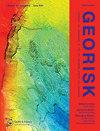Characterisation for spatial distribution of mining-induced stress through deep learning algorithm on SHM data
IF 4.8
3区 工程技术
Q1 ENGINEERING, GEOLOGICAL
Georisk-Assessment and Management of Risk for Engineered Systems and Geohazards
Pub Date : 2023-01-02
DOI:10.1080/17499518.2023.2172188
引用次数: 3
Abstract
ABSTRACT The study of mining-induced stress is essential to ensure the safety production of coalmine. Due to the limited number of monitoring points and local monitoring area, the perception of structure status is insufficient. This study aims to present a deep learning (DL) model to derive the stress distribution characteristics of the overall coalmine roof. First, the framework of spatial deduction model termed as transferring convolutional neural network (TCNN) is presented, where the convolutional neural network is transferred on different datasets. According to this framework, the spatial correlations of structural mechanical responses at different heights above roadway roof are learned through numerical simulation. Subsequently, the learned results are transferred to monitoring data to derive the actual state of the overall roof. In order to verify the reliability of the TCNN model, the stress sensor is installed in the derived plane to collect the actual data, and two indicators are adopted to evaluate the reasonability of deduction results. Experimental results indicated that 92.25% features of mining-induced stress distribution are captured by the TCNN model and the deduction error is 2.037 MPa. Therefore, the presented model is reliable to obtain the overall mechanical state of the coalmine roof, and it is supposed to promote the application of DL in underground construction.基于SHM数据的深度学习算法表征采动应力空间分布
摘要采动应力的研究是保证煤矿安全生产的必要条件。由于监测点数量和局部监测面积有限,对结构状态的感知不足。本研究旨在提出一种深度学习(DL)模型来推导整个煤矿顶板的应力分布特征。首先,提出了一种称为传递卷积神经网络(TCNN)的空间演绎模型框架,其中卷积神经网络在不同的数据集上进行传递。在此框架下,通过数值模拟了解了巷道顶板不同高度下结构力学响应的空间相关性。随后,将学习到的结果转化为监测数据,得出整个顶板的实际状态。为了验证TCNN模型的可靠性,在推导平面上安装应力传感器采集实际数据,并采用两个指标评价推导结果的合理性。试验结果表明,TCNN模型能捕捉到92.25%的采动应力分布特征,扣除误差为2.037 MPa。因此,所建立的模型能够可靠地获得煤矿顶板的整体力学状态,有望促进深度挖掘技术在井下施工中的应用。
本文章由计算机程序翻译,如有差异,请以英文原文为准。
求助全文
约1分钟内获得全文
求助全文
来源期刊
CiteScore
8.70
自引率
10.40%
发文量
31
期刊介绍:
Georisk covers many diversified but interlinked areas of active research and practice, such as geohazards (earthquakes, landslides, avalanches, rockfalls, tsunamis, etc.), safety of engineered systems (dams, buildings, offshore structures, lifelines, etc.), environmental risk, seismic risk, reliability-based design and code calibration, geostatistics, decision analyses, structural reliability, maintenance and life cycle performance, risk and vulnerability, hazard mapping, loss assessment (economic, social, environmental, etc.), GIS databases, remote sensing, and many other related disciplines. The underlying theme is that uncertainties associated with geomaterials (soils, rocks), geologic processes, and possible subsequent treatments, are usually large and complex and these uncertainties play an indispensable role in the risk assessment and management of engineered and natural systems. Significant theoretical and practical challenges remain on quantifying these uncertainties and developing defensible risk management methodologies that are acceptable to decision makers and stakeholders. Many opportunities to leverage on the rapid advancement in Bayesian analysis, machine learning, artificial intelligence, and other data-driven methods also exist, which can greatly enhance our decision-making abilities. The basic goal of this international peer-reviewed journal is to provide a multi-disciplinary scientific forum for cross fertilization of ideas between interested parties working on various aspects of georisk to advance the state-of-the-art and the state-of-the-practice.

 求助内容:
求助内容: 应助结果提醒方式:
应助结果提醒方式:


